Condensation polymers Study guides, Revision notes & Summaries
Looking for the best study guides, study notes and summaries about Condensation polymers? On this page you'll find 371 study documents about Condensation polymers.
Page 4 out of 371 results
Sort by

-
Fundamentals of Biology Exam Questions and Answers 100% Verified
- Exam (elaborations) • 20 pages • 2024
-
- £10.94
- + learn more
Fundamentals of Biology Exam Questions and Answers 100% Verified any substance that takes up space and has mass is called _____ matter an ______ is a substance that has specific chemical and physical properties element an _____ is the smallest unit of matter that still retains all the chemical properties of an element atom can an atom break-down into something smaller, while still retaining the properties of the original element? no molecules result whenever _____ atoms join together...
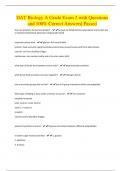
-
DAT Biology A Grade Exam 2 with Questions and 100% Correct Answers| Passed
- Exam (elaborations) • 16 pages • 2024
-
- £9.32
- + learn more
How are polymers formed and broken? - formed via dehydration(condensation) and broken due to hydration (hydrolysis dissolution of glycosidic bond) important amino acids - glycine= R=H very flexible proline= fixed, and very rigid R=secondary amino loop, prevent amino acid from alpha helices cystine= can form disulfide bridges methionine= also contains sulfur and is the start codon AUG
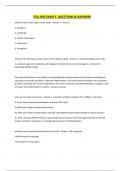
-
CELL BIO EXAM 3 QUESTIONS & ANSWERS
- Exam (elaborations) • 34 pages • 2024
-
- £13.37
- + learn more
CELL BIO EXAM 3 QUESTIONS & ANSWERS what are the 6 major types of cell death - Answer-1. necrosis 2. apoptosis 3. autophagy 4. mitotic catastrophe 5. senescence 6. ferroptosis what are the two major reasons that cell-cell death is good - Answer-1. maximize killing cancer cells 2. to prevent genomic instability and malignant transformation due to damage in a normal cell (especially dsDNA breaks) This uncontrolled form of cell death is morphologically characterized by cell membrane swel...
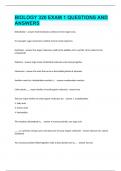
-
Biology 320 Exam 1 questions and answers
- Exam (elaborations) • 15 pages • 2024
- Available in package deal
-
- £13.37
- + learn more
Dehydration Small molecules combine to form larger ones. For example: sugar monomers combine to form starch polymers Hydrolysis One larger molecule is split by the addition of H+ and OH- (from water) to the components Polymers large chains of identical molecular units strung together Monomers the units that serve as the building blocks of polymers Another name for a dehydration reaction is... condensation reaction Cells contain ___ major families of sma...
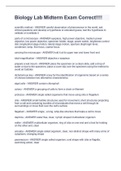
-
Biology Lab Midterm Exam Correct!!!!
- Exam (elaborations) • 5 pages • 2023
-
- £9.32
- 1x sold
- + learn more
scientific method - ANSWER careful observation of phenomenon in the world, ask critical questions and develop a hypothesis or educated guess, test the hypothesis to validate or invalidate it parts of a microscope - ANSWER eyepiece, high power objective, medium power objective, low power objective, specimen holder, stage, power switch, brightness control dial, longitudinal stage motion, lateral stage motion, aperture diaphragm lever, condenser, lamp, fine focus, coarse focus carrying the mi...

-
Test Bank For Becker’s World of the Cell, 9th Edition Jeff HardinGreg Bertoni
- Exam (elaborations) • 483 pages • 2022
-
- £16.22
- 1x sold
- + learn more
Test Bank For Becker’s World of the Cell, 9th Edition Jeff HardinGreg Bertoni Chapter 2 The Chemistry of the Cell 2.1 Multiple-Choice Questions 1) What atom forms the backbone of almost all biological molecules? A) hydrogen B) nitrogen C) carbon D) sulfur E) phosphorus Answer: C Chapter Section: 2.1 Bloom's Taxonomy: Knowledge Learning Outcome: 2.1 Global LO: G7 2) Ribose has five carbon atoms, of which three are asymmetric. What is the maximum number of stereoiso...

-
MODULE 8 PORTAGE 219 ORGANIC CHEMISTRY EXAM | QUESTIONS & ANSWERS (VERIFIED) | LATEST UPDATE | GRADED A+
- Exam (elaborations) • 21 pages • 2024
-
- £11.75
- + learn more
1 MODULE 8 PORTAGE 219 ORGANIC CHEMISTRY EXAM | QUESTIONS & ANSWERS (VERIFIED) | LATEST UPDATE | GRADED A+ large molecule made by repetitive linking of smaller units (monomers) Correct Answer: Polymer very large molecule composed of thousands of covalently bonded atoms (ex: polymer) Correct Answer: Macromolecule two ways polymers are made Correct Answer: 1. natural (in nature) 2. synthetic (in lab) natural polymers Correct Answer: rubber, carbs: starch & cellulose, proteins, nu...
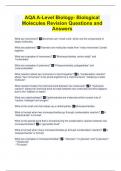
-
AQA A-Level Biology- Biological Molecules Revision Questions and Answers
- Exam (elaborations) • 11 pages • 2024
- Available in package deal
-
- £6.89
- + learn more
What are monomers? Monomers are *small units* which are the components of larger molecules. What are polymers? Polymers are molecules made from *many monomers* joined together. What are examples of monomers? *Monosaccharides, amino acids* and *nucleotides* What are examples of polymers? *Polysaccharides, polypeptides* and *polynucleotides* What reaction allows two monomers to bond together? A *condensation reaction* allows *two monomers* to be joined together by a chemical bond, *r...
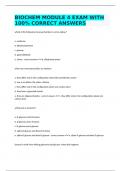
-
BIOCHEM MODULE 4 EXAM WITH 100% CORRECT ANSWERS
- Exam (elaborations) • 12 pages • 2024
-
- £10.13
- + learn more
which of the following monosaccharides is not an aldose? a. erythrose b. dihydroxyacetone c. glucose d. glyceraldehyde e. ribose - correct answer b. dihydroxyacetone when two monosaccharides are epimers: a. they differ only in the configuration about the penultimate carbon b. one is an aldose, the other a ketose c. they differ only in the configuration about one carbon atom d. they form o-glycosidic bonds e. they are oligosaccharides - correct answer c. they differ only in the ...
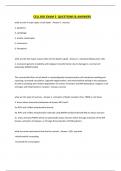
-
CELL BIO EXAM 3 QUESTIONS & ANSWERS
- Exam (elaborations) • 34 pages • 2024
-
- £13.37
- + learn more
CELL BIO EXAM 3 QUESTIONS & ANSWERS what are the 6 major types of cell death - Answer-1. necrosis 2. apoptosis 3. autophagy 4. mitotic catastrophe 5. senescence 6. ferroptosis what are the two major reasons that cell-cell death is good - Answer-1. maximize killing cancer cells 2. to prevent genomic instability and malignant transformation due to damage in a normal cell (especially dsDNA breaks) This uncontrolled form of cell death is morphologically characterized by cell membrane swel...

How much did you already spend on Stuvia? Imagine there are plenty more of you out there paying for study notes, but this time YOU are the seller. Ka-ching! Discover all about earning on Stuvia


